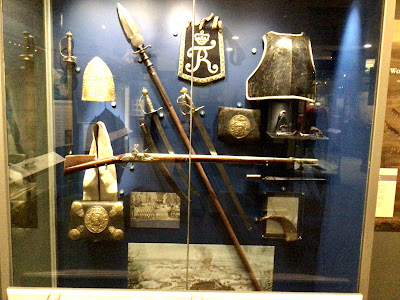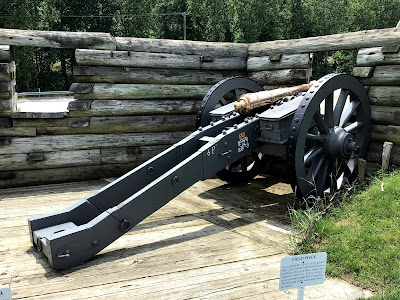 |
| Fort Ligonier in Pennsylvania |
Click or double click on all pictures to enlarge.
On the last day of our trip to visit battlefields in the Eastern United States, Lelia and I stopped in at Fort Ligonier in western Pennsylvania. Click on the link here for the fort web page: Fort Ligonier Site
The fort is a privately held nonprofit organization. It's website offers this short historical blurb about the history of Fort Ligonier:
As summer waned in 1758, the site of a new fortification was chosen by the British army that overlooked the Loyalhanna Creek. It was the last in a string of fortifications along the newly cut Forbes Road that would ultimately stretch from Philadelphia to the site of French Fort Duquesne, the ultimate objective of the Forbes Campaign. When Fort Duquesne fell to the British army in late November of 1758, construction of a new fort, Fort Pitt, began, and the land on which it rose was named Pittsburgh. Find out more about how Fort Ligonier made Pittsburgh possible as you explore the grounds of the finest reconstructed fortification from the French and Indian War.
The museum has an awesome collection of 18th British artillery equipment and wagons, as well as a rather nice (and surprising) collection of historical artifacts from the Seven Years War in Europe. Here is a sampling of some of the Prussian SYW military artifacts in the museum:
 |
| Prussian artifacts from the Seven Years War. The cuirassier sabretache and cuirass are of particular note. The image also shows an officer's pontoon, a grenadier mitre, musketeer and grenadier leather cartridge boxes, among other items. |
 |
| Prussian grenadier mitre. |
 |
| Prussian grenadier cartridge box. |
 |
| Prussian musketeer cartridge box. |
Let us move along to pictures of the collection of British artillery and artillery equipment wagons.
 |
| British 6-pound cannon and limber. |
 |
| A closer view of the British limber. |
 |
Did you ever wonder how an artillery wheel stayed on the axle of the gun carriage?
You pull out the pin from the axle and off slides the wheel. |
 |
A tampion placed in the mouth of the barrel keeps water and dust
out of the barrel when the gun is on the move with its limber. |
 |
| A small British Howitzer |
 |
| Some of the detail on the howitzer barrel. |
 |
| A wall mounted swivel gun. Every fort should have one of these. |
 |
Supporting artillery equipment, from left to right:
2-wheel powder wagon, 2-wheel tumbrel, Conestoga Wagon (blue), f
ield forge wagon, and 4-wheel munitions wagon. |
 |
| British artillery limbers |
 |
| From left to right: light 12-pounder, mortar, small Coehorn mortar, some Olde Coote, and a 6-pounder. |
 |
| Close up view of the British 6-pounder. |
 |
| The business end of the British light 12-pounder. |
 |
| British light 12-pound cannon. |
 |
| The royal cypher engraved on the barrel of the 12-pounder. |
 |
| British 8-inch howitzer capable of firing exploding shell and canister or grape shot. |
 |
| British 4.5-inch Coehorn Mortar |
Here are some additional pictures of the fort's defenses:
 |
| Moat supporter by fascines, cheveau-de-frise, and other sharp pointy sticks. |
 |
| Inside the fort. left to right: 8-inch howitzer, 12-pound gun, and 4.5-inch Coehorn Mortar. |
Fort Ligonier is DEFINITELY worth stopping to see if you are near Pittsburgh, Pennsylvania. It is just off of the Pennsylvania Turnpike, about a 20-minute drive, and is open every day of the week from 10 AM to 5PM.
Exit the turnpike at the Donegal exit and drive north on highway 711 to Ligonier, Pennsylvania.
I like to stop in for a visit every time a pass through this part of the country, usually while driving to Historicon convention in the summer.



























A really interesting set of pictures there Jim. I have enjoyed following your battlefield tours.
ReplyDeleteSuperb post.
ReplyDeleteI enjoyed your tour of Fort Ligonier very much. Thank you.
ReplyDeleteWhat a marvellous fort and collection of matériel in such fine condition. Lovely photos too, thanks.
ReplyDeleteRegards, James
Great photos, awesome fort! Everything is in such great condition. I must visit next time I’m in the area.
ReplyDelete